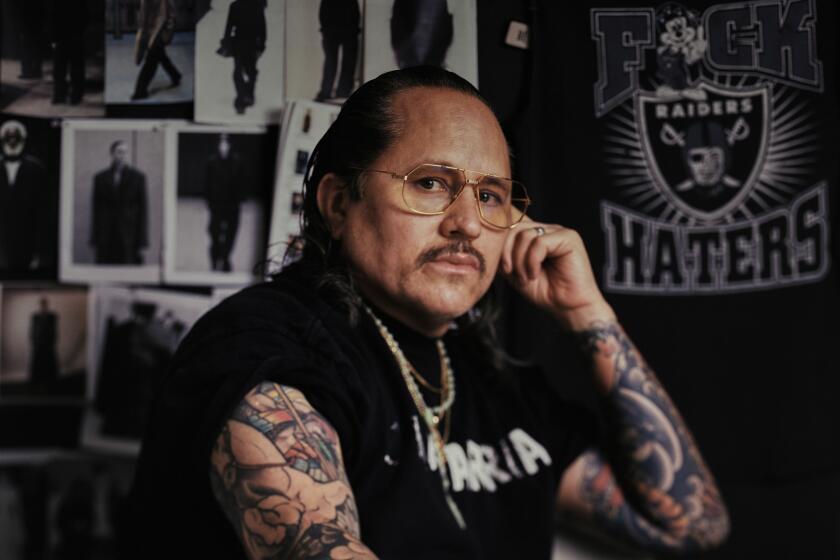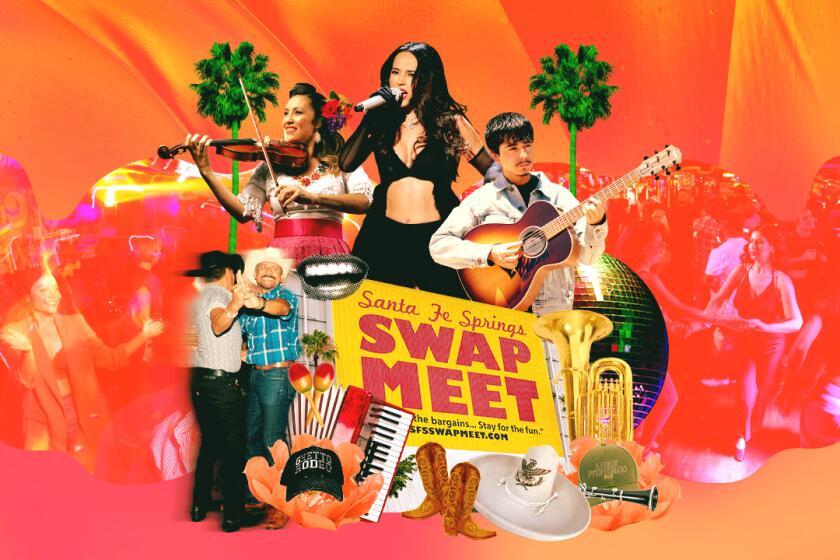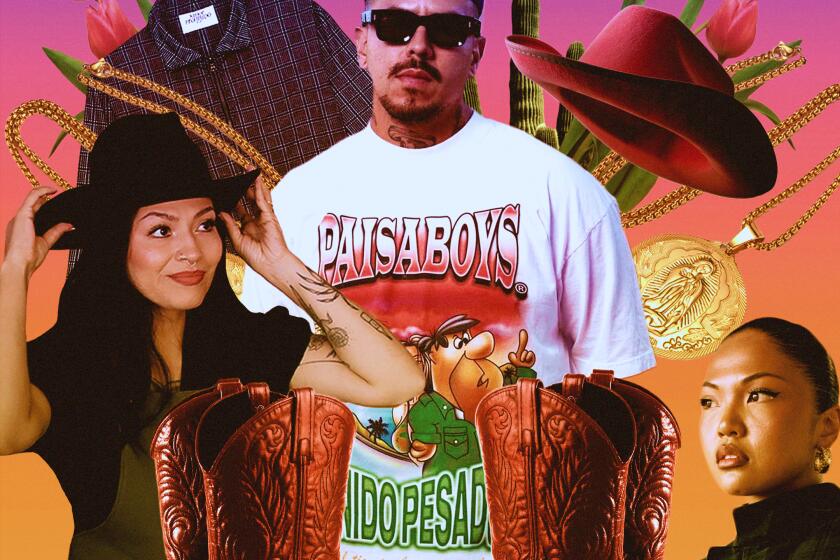
Six months ago, before Willy Chavarria had even begun drafting the designs of his Spring/Summer 2025 collection, he knew exactly how he would open his show: His guests would enter a space that was largely unadorned, aside from a prominently featured American flag. As they settled into their seats, sierreño group Yahritza y Su Esencia would file down the runway, accompanied by a trio of mariachis. There, with the flag as their backdrop, they would perform a wrenching rendition of Juan Gabriel’s “Querida.”
‘No matter what I’m doing, you’ll always know where I’m from, my influences and my culture.’
Over the years, the Mexican American designer has earned a reputation for keeping the audiences at New York Fashion Week on their toes, putting together evocative runway presentations that seamlessly blend politics, identity and fashion. His designs often draw on different eras of Chicano culture, incorporating elements of cholo street style or the exaggerated silhouettes of 1940s zoot suits to challenge ideas about what constitutes high fashion and reclaim clothing that’s historically been appropriated or stigmatized.
For him, “Querida” was the perfect way to introduce a collection he titled “América.”
“The song is about yearning for a loved one,” he says. “I just kept thinking about that as a metaphor for our country. The United States is a place people dream of as a land of opportunity and perfection, but once you’re here, you realize we’re actually just yearning for the promise of that.”
Models walked down the runway sporting looks that drew inspiration from what Chavarria described as “the real América”: the working-class laborers and migrant farmers who are the backbone of the country. Through his eyes, their uniforms and day-to-day workwear were transformed into expertly tailored trousers, jackets and collared shirts, along with bandannas and wide-brimmed hats, paired with shirts that read “Willy Chavarria Fashion Services.”
De Los spoke with Chavarria about his NYFW show, drawing inspiration from working-class people and more. The following interview has been lightly edited for clarity.
When did you first nail down the concept for this show?
Because we knew we were doing a show so close to the presidential election, I wanted to do something quite stately that would highlight part of the country we live in and hopefully motivate people to vote. Usually, the way we design is by starting off with the message and the vibe, and then we interpret that into the clothing. We outlined categories like workwear, for example, that would help us tell a narrative, because we wanted to celebrate the workers of this country.

How did you land on having Yahritza y Su Esencia perform?
Before we even started sketching, that was something I wanted to make happen. I was just a fan of theirs, and then someone from my team met someone from their team, and we just started talking. I asked them, “Would you guys ever do Juan Gabriel’s ‘Querida’?” I think at first they weren’t so into the song, they wanted to do some new music. [Laughs.] But they did it, and it was such a pleasure and an honor to work with them. During the rehearsals, I had chills just thinking about them under that American flag. That track is one that so many of us know so well, and I just knew that it would be so moving to hear it through this new, vibrant voice. I also just loved how the song related to the story of the show.
There are a lot of contradictory emotions that come with being Mexican American in a country that isn’t always kind to us. How did you want to tackle those ideas through clothing?
I never dreamt I would be doing a show with an American flag in it. But with the elections approaching, I was just thinking more and more about how some Latinos are either on the fence about who they’re voting for, or on the side of a politician who’s only going to repress us. So I wanted to make sure that the American flag was there to acknowledge that even though this country was founded on some of the worst things imaginable, and it can be a messed-up place, the fact is: We’re here. We belong here, we have a voice, and we have the ability to come together and create a future for ourselves here. That’s why I thought a lot about the United Farm Workers movement and the civil rights movement during the designing of this collection.
Música Mexicana has been pushed into the mainstream over the last five years by Gen Z and millennial Latino audiences. Here’s a guide on the genre’s essential instruments, where to find the best música Mexicana-themed parties, where to shop for the perfect vaquero outfit and more.
Speaking of the United Farm Workers, I heard that your family has a bit of a connection to Cesar Chavez.
[Laughs.] Our family’s claim to fame is that Cesar Chavez had coffee at our table in Huron, Calif. Huron is such a small town, and it’s all agricultural. There’s one Catholic church, and our house was right across the street from it, so the priest would come over every day for breakfast, lunch and dinner, and my grandmother would cook. One morning, Cesar Chavez came. And actually, I became friends with Anthony Chavez, his grandson, during the making of this show. He helped us a lot with communicating with the United Farm Workers.
Whether you’re in the market for a custom-fit tejana, a show-stopping pair of boots or even a new matching set, these places bring both a fresh and a classic feeling to shopping.
Was your family involved in the agricultural industry?
Yeah, we were a family of migrant workers, and then my grandfather settled in Huron and my family stayed there. So my father grew up in Huron, working in the fields all his life.
How much of an adjustment was it to go from a town like Huron into the fashion space?
I’ve been through many culture shocks in my life, but probably the most intense was when I first moved to New York from California. Even though I’d been working in California for a cycling apparel brand and for Joe Boxer, my first job here was with Ralph Lauren, and that was a major culture shock. I hated New York for the first two years I was here. Going to work at Ralph Lauren, I didn’t really get the respect that I deserved there at the time. People were not nice, and it felt heavy. But at the same time, I was very much aware of the long-standing racism that exists in the business world, so I wanted to just make the best of my own career. I learned all the lessons I could from every job I ever had and brought those along with me.
Something I loved about this collection is that every look conjured up memories of a real person. Were you drawing from real-life people who were part of your life at some point?
I kind of feel like they were all characters in my daily life. The farmworker inspiration was something very, very special to me, because when I was growing up, I always saw the clothes that they wore as very dramatic. It’s such a labor-intensive job, and you have to have such a great spirit to do it, so the clothes they wore were always very emotional and romantic to me. I always wondered how I could interpret them into something that could be wearable but styled in a way that still told their story.

Workwear is really having a moment right now, but the pieces you designed and the way they were styled felt like a reminder that these are clothes we’ve been wearing.
We have been wearing these things. There is an ownership that we have over some of this stuff, and I’m happy for us to take that back, because our culture has been borrowed from and exploited in so many ways by other people. It’s nice when we’re sharing our culture with the world, because it’s a different vibe entirely.
In many ways, it’s funny to think that somebody’s going to pay $1,300 for a workwear jacket I designed based on something my grandfather wore. I think it’s cool that I’m able to be a luxury designer, because that position has been so exclusive to people who are not like me, so I want to occupy that space. Anytime we open a door, I want to show that we belong, and that we can be just as good, if not better, than everyone else. At the same time, I don’t want my clothes to always be exclusive high-end clothing. That’s why I’ve been working on direct-to-consumer clothing, so I’ll be able to make some collections for lower price points; that way my brand stays open to everybody. That’s what makes the Adidas collab so cool.
Right, you surprised the audience by revealing a whole Adidas collaboration at your show.
Yeah, I was really excited when they hit me up, because they’re such a big mega-brand. For me to be able to do what I do through their megaphone is amazing. And I feel like I bring a lot to the table for them.
There were so many great details in the styling of this show. What can you tell me about them?
I started with the glasses because I felt like they give people dimension, and in some cases, they make them look more serious. I liked taking these models in their outfits where they’re going to work, and putting on eyewear that made them look more studied. And key rings were such a cool accessory just symbolizing “We’re all here doing our jobs,” even me. That’s why the logo was “Willy Chavarria Fine Fashion Services.” I’m still in the service field in a way.
What was the casting process like for this show?
Every time we do casting, I really like to work with people who aren’t professional models, or who are just starting out. The first four or five people who walked the show hadn’t modeled before. I just wanted new faces — people who had stories themselves, who didn’t feel like models but real people. It’s usually more personal when the audience can see people who look like them, or who remind them of people they know.
Your shows have really helped change the landscape of NYFW. When people go to see a Willy Chavarria collection, they know that the audience and the models coming down the runway are going to be diverse. How do you feel about that expectation?
I take it very seriously, and I’m very happy to create a space where people feel welcome and seen. I also want to make sure that I protect it as the brand grows, and more and more people get involved. I want our messaging to stay consistent.
As your profile has risen in the fashion world, how do you feel about the idea of becoming “mainstream.” Is it a double-edged sword?
There was a time when I thought I could just be an industry outsider, do my own thing and succeed that way. But I discovered that even though I want to do something different, I still have to deal with the industry’s inner workings to get support and visibility. It’s kind of a give-and-take. Yes, I have to deal with people who might have old values, or dated ideals, but I’m firm and I hold my ground. I have to have a steadfast vision for what I want, so I won’t be distracted by the madness.
You came up in the industry working for brands like Ralph Lauren and Joe Boxer that feel very quintessentially “American.” Looking at your collection, how do you feel about the “America” you’re designing for?
There are so many brands that use their platform to amplify what America is. So I just wanted to flip the script a little bit and show what America really looks like, and who we really are. I felt good about it, my team felt good about it, and I think the story resonates really well. I think we’re kind of past the white idealism that we’ve been given for so long as the standard of luxury. It’s a new day now, and I think it’s very important for people to feel that they belong instead of being excluded.
Looking ahead, what’s your ultimate dream for “Willy Chavarria Fashion Services”?
I would love to be one of those household names. I would love to be a Ralph Lauren or a Tommy Hilfiger, or a Michael Kors, but just offer something different. I would love to have a voice that large, and be able to sell things from Kohl’s to Dover Street Market and everywhere in between. I want to have that kind of reach. That’s my goal.
Cat Cardenas is a writer and photographer based in Austin. Her work has appeared in Rolling Stone, New York Magazine, Harper’s Bazaar, GQ and other publications.
More to Read
The Latinx experience chronicled
Get the Latinx Files newsletter for stories that capture the multitudes within our communities.
You may occasionally receive promotional content from the Los Angeles Times.









